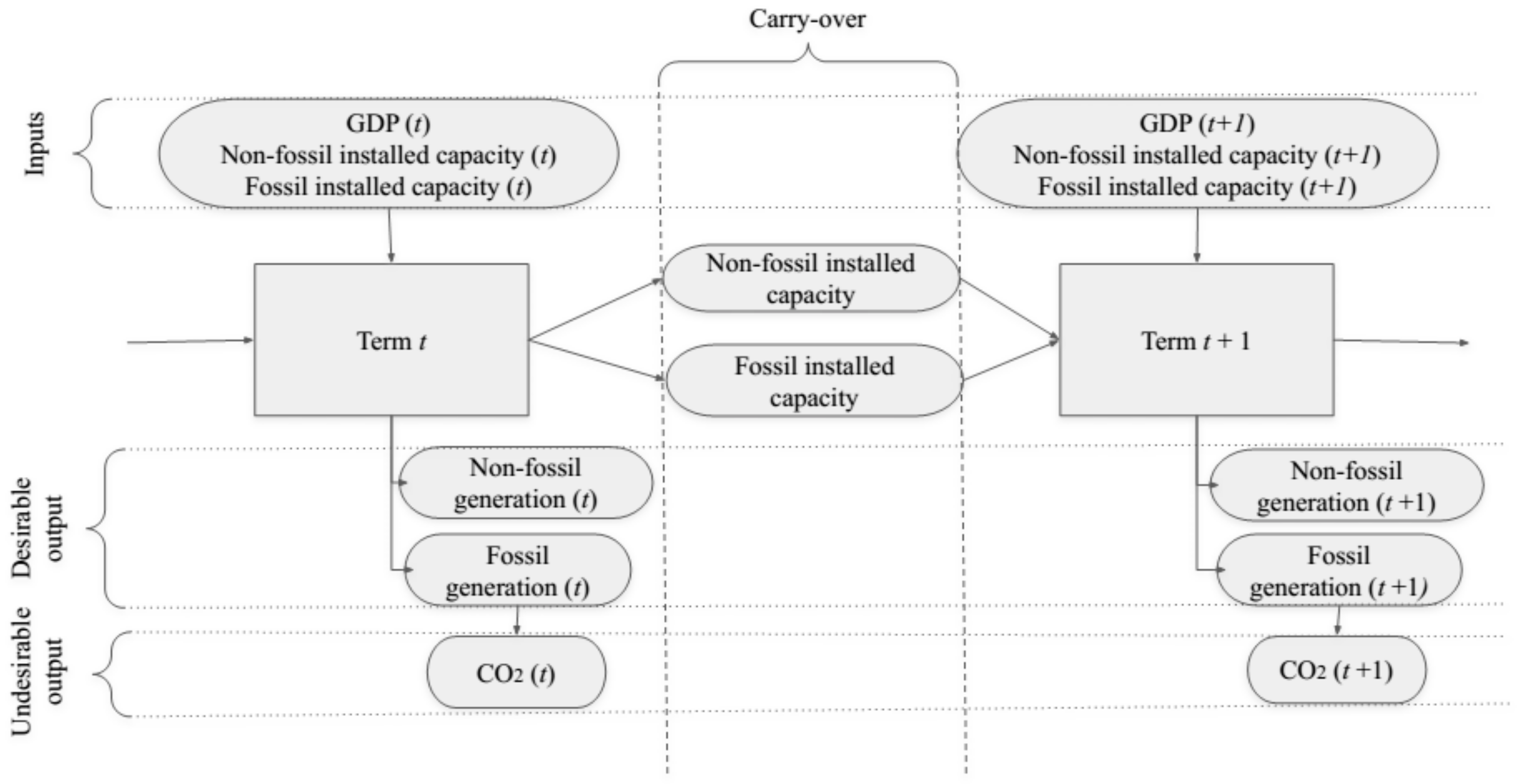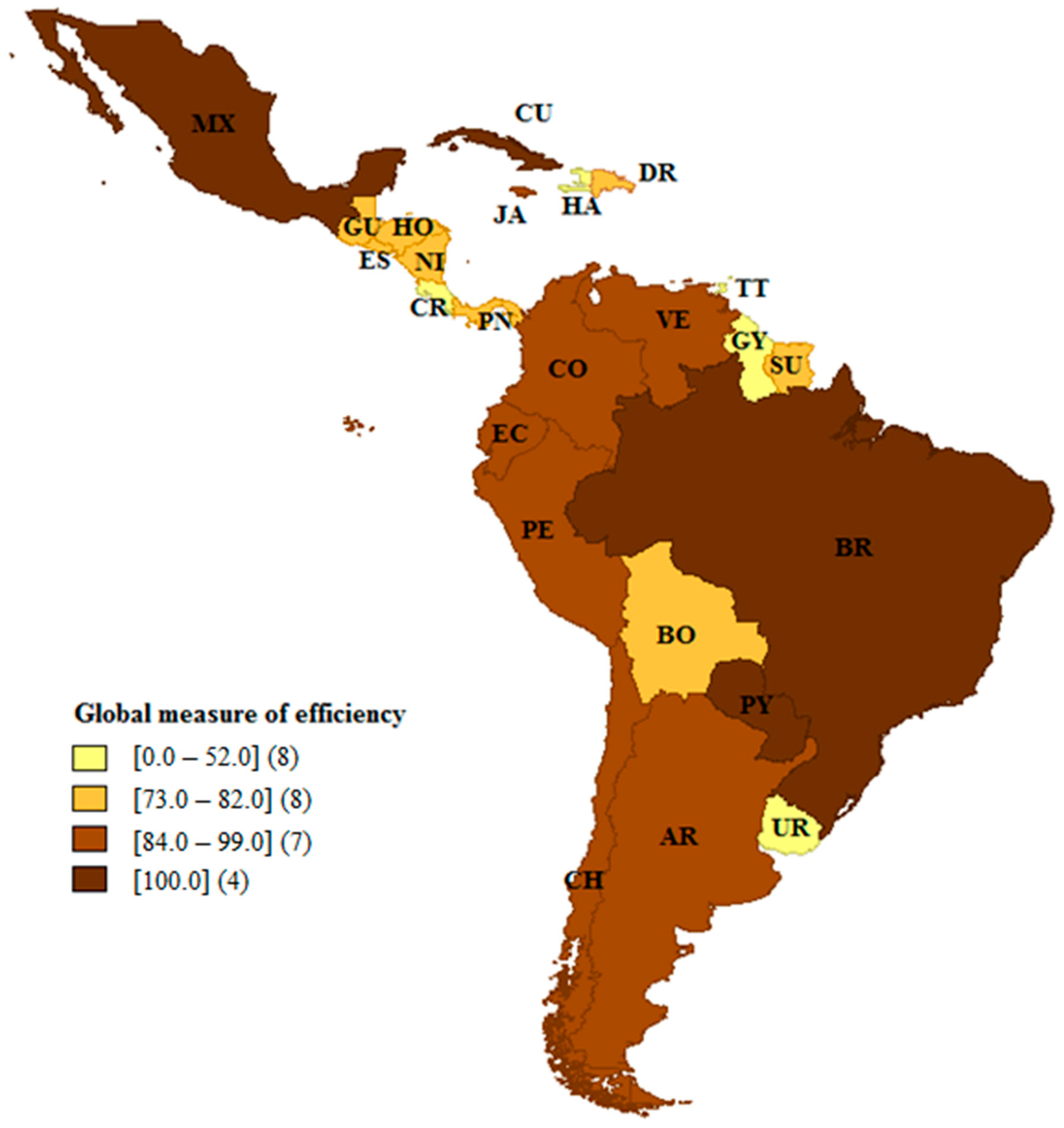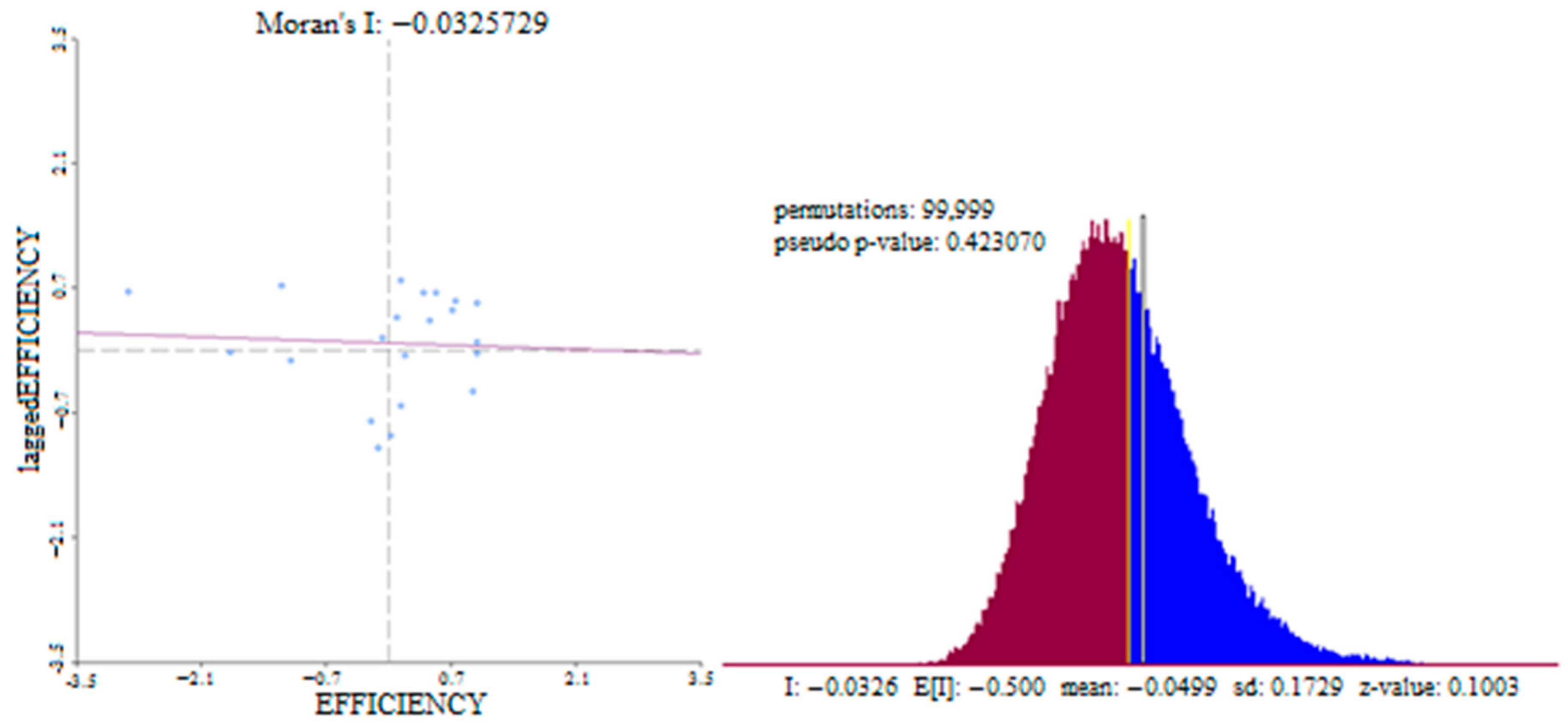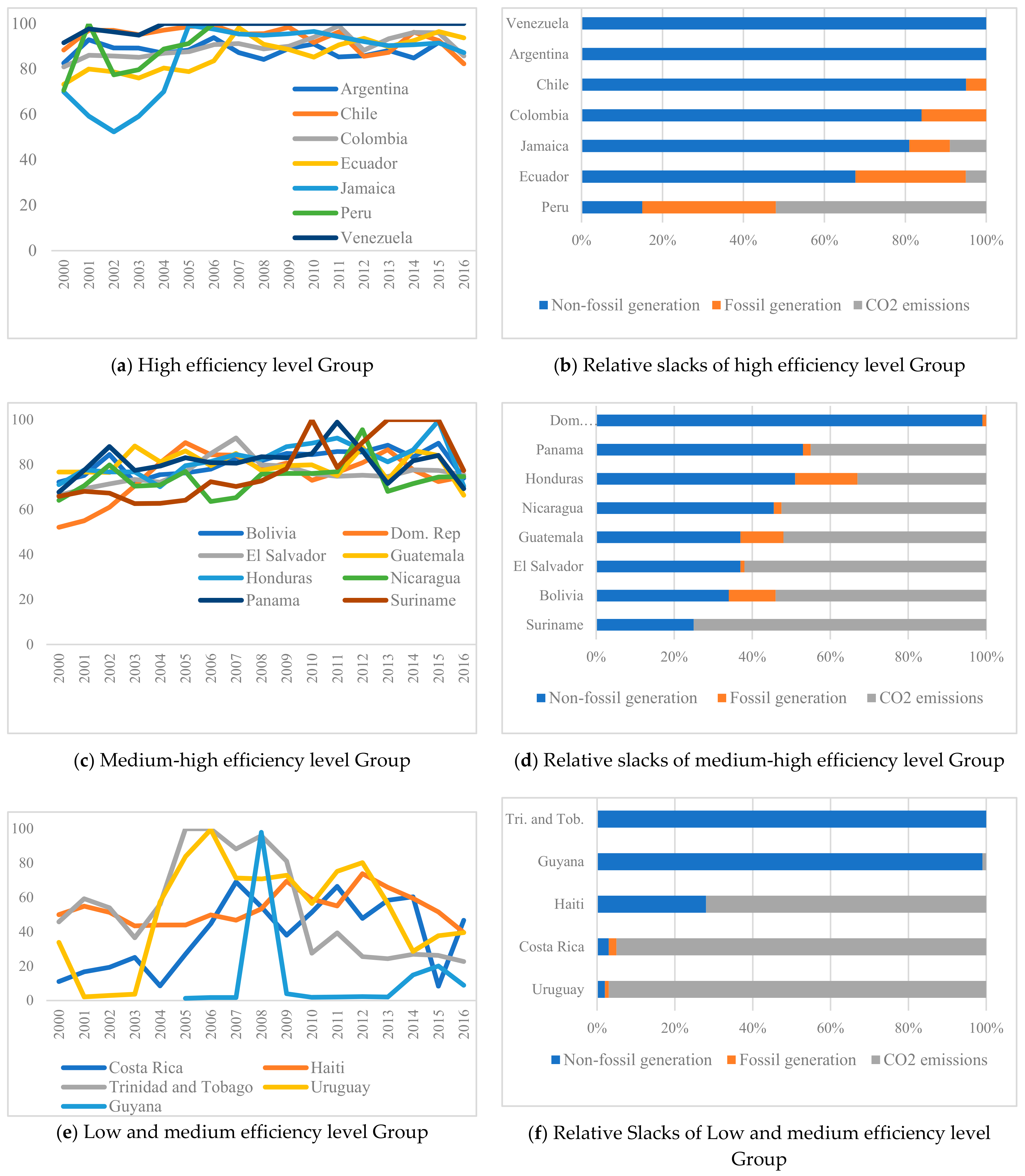Dynamic Data Envelopment Analysis Model Involving Undesirable Outputs in the Electricity Power Generation Sector: The Case of Latin America and the Caribbean Countries
Abstract
1. Introduction
2. Literature Review
2.1. DEA in Power Generation
2.2. Environmental DEA
2.3. Dynamic DEA
3. Materials and Methods
3.1. Data and Sources
3.2. Definition of the Variables
- Desirable output
- Undesirable output
- Inputs
- Link variables
3.3. Model Approach
- Equations (1)–(3) are associated with constraints on inputs:
4. Results
4.1. Descriptive Analysis of the Variables
- Electricity generation
- CO2 emissions
- GDP per capita
- Installed capacity
4.2. Electricity Generation Sector and Efficiency Measure
4.2.1. Aggregate Spatial Analysis of the Overall Efficiency Measure
4.2.2. Measure of Efficiency of Electricity Generation
5. Conclusions
Author Contributions
Funding
Conflicts of Interest
Nomenclature
| DEA | Data envelopment analysis |
| DMU | Decision-making units |
| GHG | Greenhouse gases |
| GW | Gigawatt |
| TWh | Terawatt-hours |
| MTm | Million metric tons |
| DO_NF | Desirable output: non-fossil generation |
| DO_F | Desirable output: fossil generation |
| GDP | Gross Domestic Product |
| IC_NF | Installed capacity: non-fossil sources |
| IC_F | Installed capacity: fossil sources |
| SDO_NF | Slack associated with desirable output: non-fossil generation |
| SDO_F | Slack associated with desirable output: fossil generation |
| SUO_CO2 | Slack associated with undesirable output: CO2 emissions |
| S_GDP | Slack associated with GDP per capita |
| SIC_NF | Slack associated with installed capacity: non-fossil sources |
| SIC_F | Slack associated with installed capacity: fossil sources |
References
- Mahmoodi, M. The Relationship between Economic Growth, Renewable Energy, and CO2 Emissions: Evidence from Panel Data Approach. Int. J. Energy Econ. Policy 2017, 7, 96–102. [Google Scholar]
- EIA. International–Electricity. Available online: https://www.eia.gov/international/data/world/electricity/electricity-generation? (accessed on 17 March 2020).
- REN21. Renewables 2017 Global Status Report. Available online: https://www.ren21.net/wp-content/uploads/2019/05/GSR2017_Full-Report_English.pdf (accessed on 15 January 2020).
- Eberle, A.; Heath, G. Projected Growth in Small-Scale, Fossil-Fueled Distributed Generation: Potential Implications for the U.S. Greenhouse Gas Inventory. United States. 2018. Available online: https://www.osti.gov/biblio/1431247-projected-growth-small-scale-fossil-fueled-distributed-generation-potential-implications-greenhouse-gas-inventory (accessed on 15 January 2020).
- IEA. 2018. Available online: https://webstore.iea.org/co2-emissions-from-fuel-combustion-2018-highlights (accessed on 15 January 2020).
- Sánchez, L.; Vásquez, C.; Viloria, A. The data envelopment analysis to determine efficiency of Latin American countries for greenhouse gases control in electric power generation. Int. J. Energy Econ. Policy 2018, 8, 197–208. Available online: https://www.econjournals.com/index.php/ijeep/article/view/6360 (accessed on 31 November 2019).
- Charnes, A.; Cooper, W.W.; Rhodes, E. Measuring the efficiency of decision making units. Eur. J. Oper. Res. 1978, 2, 429–444. [Google Scholar] [CrossRef]
- Mariz, F.B.; De Almeida, M.R.; Aloise, D. A review of Dynamic Data Envelopment Analysis: State of the art and applications. Int. Trans. Oper. Res. 2017, 25, 469–505. [Google Scholar] [CrossRef]
- Faere, R.; Grosskopf, S.; Lovell, C.A.K.; Pasurka, C. Multilateral Productivity Comparisons When Some Outputs are Undesirable: A Nonparametric Approach. Rev. Econ. Stat. 1989, 71, 90. [Google Scholar] [CrossRef]
- Sueyoshi, T.; Yuan, Y.; Goto, M. A literature study for DEA applied to energy and environment. Energy Econ. 2017, 62, 104–124. [Google Scholar] [CrossRef]
- Golany, B.; Roll, Y.; Rybak, D. Measuring efficiency of power plants in Israel by data envelopment analysis. IEEE Trans. Eng. Manag. 1994, 41, 291–301. [Google Scholar] [CrossRef]
- Shermeh, H.E.; Najafi, S.; Alavidoost, M. A novel fuzzy network SBM model for data envelopment analysis: A case study in Iran regional power companies. Energy 2016, 112, 686–697. [Google Scholar] [CrossRef]
- Khalili-Damghani, K.; Tavana, M.; Haji-Saami, E. A data envelopment analysis model with interval data and undesirable output for combined cycle power plant performance assessment. Expert Syst. Appl. 2015, 42, 760–773. [Google Scholar] [CrossRef]
- Yang, H.; Pollitt, M.G. The necessity of distinguishing weak and strong disposability among undesirable outputs in DEA: Environmental performance of Chinese coal-fired power plants. Energy Policy 2010, 38, 4440–4444. [Google Scholar] [CrossRef]
- Sueyoshi, T.; Goto, M. DEA environmental assessment of coal fired power plants: Methodological comparison between radial and non-radial models. Energy Econ. 2012, 34, 1854–1863. [Google Scholar] [CrossRef]
- Cherchye, L.; De Rock, B.; Walheer, B. Multi-output efficiency with good and bad outputs. Eur. J. Oper. Res. 2015, 240, 872–881. [Google Scholar] [CrossRef]
- Chang, D.S.; Yang, F.-C. Assessing the power generation, pollution control, and overall efficiencies of municipal solid waste incinerators in Taiwan. Energy Policy 2011, 39, 651–663. [Google Scholar] [CrossRef]
- Tao, Y.; Zhang, S. Environmental efficiency of electric power industry in the Yangtze River Delta. Math. Comput. Model. 2013, 58, 927–935. [Google Scholar] [CrossRef]
- Dogan, N.O.; Tugcu, C.T. Energy Efficiency in Electricity Production: A Data Envelopment Analysis (DEA) Approach for the G-20 Countries. Int. J. Energy Econ. Policy 2015, 5, 246–252. Available online: https://ideas.repec.org/a/eco/journ2/2015-01-19.html (accessed on 31 November 2019).
- Whiteman, J.L. The technical efficiency of developing country electricity systems. In Proceedings of the 1995 International Conference on Energy Management and Power Delivery EMPD ’95, Singapore, 21–23 November 1995; Volume 2, pp. 504–509. [Google Scholar]
- Yunos, J.M.; Hawdon, D. The efficiency of the National Electricity Board in Malaysia: An intercountry comparison using DEA. Energy Econ. 1997, 19, 255–269. [Google Scholar] [CrossRef]
- Bi, G.; Liang, N.; Wu, J.; Liang, L. Radial and non-radial DEA models undesirable outputs: An application to OECD countries. Int. J. Sustain. Soc. 2010, 2, 133. [Google Scholar] [CrossRef]
- Zhou, P.; Ang, B.; Wang, H. Energy and CO2 emission performance in electricity generation: A non-radial directional distance function approach. Eur. J. Oper. Res. 2012, 221, 625–635. [Google Scholar] [CrossRef]
- Li, J.; Geng, X.; Li, J. A Comparison of Electricity Generation System Sustainability among G20 Countries. Sustainability 2016, 8, 1276. [Google Scholar] [CrossRef]
- Dyson, R.; Allen, R.; Camanho, A.; Podinovski, V.; Sarrico, C.; Shale, E. Pitfalls and protocols in DEA. Eur. J. Oper. Res. 2001, 132, 245–259. [Google Scholar] [CrossRef]
- Barros, J. Performance measurement of thermoelectric generating plants with undesirable outputs and random parameters. Int. J. Electr. Power Energy Syst. 2013, 46, 228–233. [Google Scholar] [CrossRef]
- Tone, K. Dealing with Undesirable Outputs in DEA: A Slacks-based Measure (SBM), 2003 Approach. Available online: https://www.researchgate.net/profile/Kaoru_Tone/publication/284047010_Dealing_with_undesirable_outputs_in_DEA_a_Slacks-Based_Measure_SBM_approach/links/56ebdf2b08aee4707a384415/Dealing-with-undesirable-outputs-in-DEA-a-Slacks-Based-Measure-SBM-approach.pdf (accessed on 4 December 2020).
- Koltai, T.; Lozano, S.; Uzonyi-Kecskés, J.; Moreno, P. Evaluation of the results of a production simulation game using a dynamic DEA approach. Comput. Ind. Eng. 2017, 105, 1–11. [Google Scholar] [CrossRef]
- Färe, R.; Grosskopf, S. Introduction. In Intertemporal Production Frontiers: With Dynamic DEA; Springer Science and Business Media LLC: Heidelberg/Berlin, Germany, 1996; pp. 1–8. [Google Scholar]
- Tone, K.; Tsutsui, M. Dynamic DEA: A slacks-based measure approach. Omega 2010, 38, 145–156. [Google Scholar] [CrossRef]
- Walheer, B. Economic growth and greenhouse gases in Europe: A non-radial multi-sector nonparametric production-frontier analysis. Energy Econ. 2018, 74, 51–62. [Google Scholar] [CrossRef]
- Amowine, N.; Ma, Z.; Li, M.; Zhou, Z.; Asunka, B.A.; Amowine, J. Energy Efficiency Improvement Assessment in Africa: An Integrated Dynamic DEA Approach. Energies 2019, 12, 3915. [Google Scholar] [CrossRef]
- Guo, X.; Lu, C.-C.; Lee, J.-H.; Chiu, Y.-H. Applying the dynamic DEA model to evaluate the energy efficiency of OECD countries and China. Energy 2017, 134, 392–399. [Google Scholar] [CrossRef]
- Şimşek, N. Energy Efficiency with Undesirable Output at the Economy-Wide Level: Cross Country Comparison in OECD Sample. Am. J. Energy Res. 2014, 2, 9–17. [Google Scholar] [CrossRef]
- Tsai, W.-H.; Lee, H.-L.; Yang, C.-H.; Huang, C.-C. Input-Output Analysis for Sustainability by Using DEA Method: A Comparison Study between European and Asian Countries. Sustainability 2016, 8, 1230. [Google Scholar] [CrossRef]
- Chen, T.-Y.; Yeh, T.-L.; Lee, Y.-T. Comparison of Power Plants Efficiency among 73 Countries. J. Energy 2013, 2013, 1–8. [Google Scholar] [CrossRef]
- Ghosh, S. Electricity supply, employment and real GDP in India: Evidence from cointegration and Granger-causality tests. Energy Policy 2009, 37, 2926–2929. [Google Scholar] [CrossRef]
- Lean, H.H.; Smyth, R. Multivariate Granger causality between electricity generation, exports, prices and GDP in Malaysia. Energy 2010, 35, 3640–3648. [Google Scholar] [CrossRef]
- Yoo, S.-H.; Kim, Y. Electricity generation and economic growth in Indonesia. Energy 2006, 31, 2890–2899. [Google Scholar] [CrossRef]
- Nemoto, J.; Goto, M. Dynamic data envelopment analysis: Modeling intertemporal behavior of a firm in the presence of productive inefficiencies. Econ. Lett. 1999, 64, 51–56. [Google Scholar] [CrossRef]
- Jiekang, W.; Zhuangzhi, G.; Fan, W. Short-term multi-objective optimization scheduling for cascaded hydroelectric plants with dynamic generation flow limit based on EMA and DEA. Int. J. Electr. Power Energy Syst. 2014, 57, 189–197. [Google Scholar] [CrossRef]
- Tone, K. Dealing with undesirable outputs in DEA: A Slacks-Based Measure (SBM) approach. In Proceedings of the North American Productivity Workshop 2004, Toronto, ON, Canada, 23–25 June 2004; pp. 44–45. [Google Scholar]
- Zhou, Z.; Liu, W. DEA Models with Undesirable Inputs, Intermediates, and Outputs. In Multiple Criteria Decision Analysis; Springer Science and Business Media LLC: Heidelberg/Berlin, Germany, 2015; pp. 415–446. [Google Scholar]
- Banker, R.D. Hypothesis tests using data envelopment analysis. J. Prod. Anal. 1996, 7, 139–159. [Google Scholar] [CrossRef]
- Banker, R.D.; Charnes, A.; Cooper, W.W. Some Models for Estimating Technical and Scale Inefficiencies in Data Envelopment Analysis. Manag. Sci. 1984, 30, 1078–1092. [Google Scholar] [CrossRef]
- Fischer, M.M.; Wang, J. Introduction. Spat. Econom. 2011, 1–11. [Google Scholar] [CrossRef]
- Ravillard, P.; Carvajal, F.; Soto, D.D.L.; Chueca, J.E.; Antonio, K.; Ji, Y.; Hallack, M.C.M. Towards Greater Energy Efficiency in Latin America and the Caribbean: Progress and Policies, Publications. Available online: https://publications.iadb.org/publications/english/document/Towards_Greater_Energy_Efficiency_in_Latin_America_and_the_Caribbean_Progress_and_Policies.pdf (accessed on 4 December 2020).
- Williamson, E. The Economic Institutions of Capitalism. J. Econ. Issues 1987, 21, 528–530. [Google Scholar] [CrossRef]
- Wiese, C.; Larsen, A.; Pade, L.-L. Interaction effects of energy efficiency policies: A review. Energy Effic. 2018, 11, 2137–2156. [Google Scholar] [CrossRef]
- Gerarden, T.D.; Newell, R.G.; Stavins, R.N. Assessing the Energy-Efficiency Gap. J. Econ. Lit. 2017, 55, 1486–1525. [Google Scholar] [CrossRef]
- International Energy Agency. Market-based Instruments for Energy Efficiency: Policy Choice and Design. 2017. Available online: https://www.raponline.org/knowledge-center/market-based-instruments-energy-efficiency-policy-choice-design/ (accessed on 4 December 2020).
- Lees, E.; Bayer, E. Toolkit for Energy Efficiency Obligations; Regulatory Assistance Project. Brussels, Belgium. 2016. Available online: https://www.raponline.org/knowledge-center/toolkit-for-energy-efficiency-obligations/ (accessed on 4 December 2020).
- Somoza, J.; Bano, J.; Llorca, M. La medición de la eficiencia energética y su contribución en la mitigación de las emisiones de CO2 para 26 países de América Latina y el Caribe. Econ. Desarro. 2014, 152, 87–106. Available online: http://scielo.sld.cu/scielo.php?pid=S0252-85842014000200006&script=sci_abstract&tlng=es (accessed on 4 December 2020).




| Country (1) | Statistic (2) | Desirable Ouput | Undesirable Output | Input | |||
|---|---|---|---|---|---|---|---|
| Non-Fossil Gen. (3) | Fossil Gen. (4) | CO2 (5) | GDP Per Capita (6) | Ins. Cap. Non-Fossil (7) | Ins. Cap. Fossil (8) | ||
| AR | Mean | 41.00 | 70.00 | 44.23 | 18,412.81 | 11.78 | 20.53 |
| SD | 3.09 | 16.80 | 9.79 | 2268.57 | 0.68 | 3.40 | |
| BO | Mean | 2.30 | 3.85 | 3.64 | 5656.90 | 0.56 | 1.22 |
| SD | 0.21 | 1.71 | 0.86 | 862.72 | 0.09 | 0.37 | |
| BR | Mean | 400.33 | 62.29 | 40.93 | 14,394.79 | 90.36 | 18.26 |
| SD | 62.27 | 34.45 | 22.37 | 1544.55 | 19.02 | 6.45 | |
| CH | Mean | 27.04 | 31.03 | 21.45 | 19,981.79 | 6.37 | 9.48 |
| SD | 3.83 | 8.83 | 6.83 | 3006.13 | 1.73 | 3.08 | |
| CO | Mean | 43.89 | 13.62 | 9.84 | 11,522.65 | 9.78 | 4.63 |
| SD | 7.07 | 5.65 | 3.53 | 1833.39 | 1.16 | 0.20 | |
| CR | Mean | 8.62 | 0.42 | 1.50 | 13,297.63 | 1.94 | 0.54 |
| SD | 1.24 | 0.34 | 0.55 | 1926.17 | 0.47 | 0.18 | |
| CU | Mean | 0.75 | 15.78 | 10.95 | 10,079.38 | 0.45 | 5.25 |
| SD | 0.17 | 1.74 | 0.90 | 2137.05 | 0.25 | 0.87 | |
| DR | Mean | 1.71 | 12.01 | 8.83 | 11,363.87 | 0.57 | 2.69 |
| SD | 0.58 | 2.37 | 1.48 | 2262.95 | 0.15 | 0.26 | |
| EC | Mean | 10.42 | 7.51 | 5.98 | 9819.95 | 2.35 | 2.47 |
| SD | 3.55 | 2.75 | 1.71 | 1232.25 | 0.85 | 0.69 | |
| ES | Mean | 3.17 | 2.09 | 2.54 | 6742.26 | 0.75 | 0.74 |
| SD | 0.64 | 0.34 | 0.50 | 542.44 | 0.15 | 0.17 | |
| GU | Mean | 5.32 | 3.54 | 3.65 | 7097.37 | 1.36 | 1.51 |
| SD | 1.66 | 0.62 | 0.50 | 472.13 | 0.61 | 0.28 | |
| HA | Mean | 0.19 | 0.51 | 1.60 | 1736.84 | 0.06 | 0.21 |
| SD | 0.07 | 0.27 | 0.26 | 59.55 | 0.00 | 0.04 | |
| HO | Mean | 2.81 | 3.43 | 3.45 | 4118.70 | 0.75 | 0.94 |
| SD | 1.00 | 0.90 | 0.56 | 378.25 | 0.35 | 0.23 | |
| JA | Mean | 0.32 | 4.79 | 4.27 | 8742.39 | 0.09 | 1.03 |
| SD | 0.15 | 1.41 | 0.99 | 239.61 | 0.04 | 0.17 | |
| MX | Mean | 50.27 | 201.74 | 126.31 | 17,608.92 | 15.22 | 42.87 |
| SD | 6.48 | 31.75 | 19.44 | 746.11 | 2.67 | 6.96 | |
| NI | Mean | 1.32 | 2.07 | 2.55 | 4361.85 | 0.40 | 0.70 |
| SD | 0.72 | 0.18 | 0.39 | 581.76 | 0.16 | 0.15 | |
| PN | Mean | 4.46 | 2.69 | 2.95 | 16,470.64 | 1.20 | 0.87 |
| SD | 1.44 | 0.68 | 0.46 | 4310.40 | 0.53 | 0.25 | |
| PR | Mean | 54.27 | 0.00 | 1.24 | 9911.98 | 8.24 | 0.01 |
| SD | 4.33 | 0.00 | 0.44 | 1439.28 | 0.64 | 0.01 | |
| PE | Mean | 21.04 | 12.23 | 8.70 | 9956.29 | 3.67 | 5.05 |
| SD | 3.61 | 6.89 | 3.92 | 2319.50 | 0.81 | 2.12 | |
| TT | Mean | 0.01 | 7.56 | 5.83 | 29,570.22 | 0.01 | 1.92 |
| SD | 0.01 | 1.64 | 0.84 | 4795.99 | 0.00 | 0.49 | |
| UR | Mean | 8.40 | 1.28 | 2.04 | 16,976.87 | 2.01 | 1.02 |
| SD | 2.71 | 1.12 | 0.91 | 3483.31 | 0.64 | 0.39 | |
| VE | Mean | 74.21 | 32.30 | 22.05 | 16,547.00 | 14.33 | 11.30 |
| SD | 9.66 | 6.16 | 4.95 | 2198.72 | 0.87 | 3.73 | |
| GU | Mean | 0.00 | 0.82 | 1.90 | 6075.02 | 0.03 | 0.33 |
| SD | 0.01 | 0.12 | 0.08 | 1059.76 | 0.01 | 0.04 | |
| SU | Mean | 0.99 | 0.71 | 1.72 | 13,847.67 | 0.19 | 0.23 |
| SD | 0.23 | 0.08 | 0.32 | 1846.36 | 0.00 | 0.04 | |
| TOTAL | Mean | 31.79 | 20.51 | 14.1 | 11,845.57 | 7.19 | 5.58 |
| Country | 2000 | 2001 | 2002 | 2003 | 2004 | 2005 | 2006 | 2007 | 2008 | 2009 | 2010 | 2011 | 2012 | 2013 | 2014 | 2015 | 2016 | Global |
|---|---|---|---|---|---|---|---|---|---|---|---|---|---|---|---|---|---|---|
| AR | 82.57 | 92.87 | 89.28 | 89.22 | 86.94 | 88.41 | 93.86 | 87.20 | 84.21 | 89.02 | 91.00 | 85.32 | 85.82 | 88.18 | 84.85 | 91.76 | 87.14 | 88.10 |
| BO | 72.23 | 75.20 | 84.48 | 72.06 | 75.57 | 76.30 | 78.00 | 82.93 | 81.78 | 84.98 | 84.44 | 85.84 | 85.57 | 88.63 | 83.34 | 89.52 | 73.99 | 80.87 |
| BR | 100.00 | 100.00 | 100.00 | 100.00 | 100.00 | 100.00 | 100.00 | 100.00 | 100.00 | 100.00 | 100.00 | 100.00 | 100.00 | 100.00 | 100.00 | 100.00 | 100.00 | 100.00 |
| CH | 88.35 | 97.07 | 97.00 | 95.13 | 97.11 | 98.62 | 99.19 | 95.37 | 95.54 | 98.43 | 91.66 | 96.36 | 85.59 | 87.36 | 96.19 | 92.49 | 82.32 | 93.75 |
| CO | 80.96 | 86.02 | 85.70 | 85.13 | 86.97 | 87.60 | 90.71 | 91.16 | 88.84 | 90.06 | 94.03 | 99.03 | 88.25 | 93.35 | 96.09 | 95.91 | 85.76 | 89.74 |
| CR | 11.03 | 16.72 | 19.35 | 25.09 | 8.55 | 26.95 | 44.67 | 69.01 | 54.52 | 38.03 | 51.40 | 66.42 | 47.83 | 58.37 | 60.37 | 8.36 | 46.70 | 38.44 |
| CU | 100.00 | 100.00 | 100.00 | 100.00 | 100.00 | 100.00 | 100.00 | 100.00 | 100.00 | 100.00 | 100.00 | 100.00 | 100.00 | 100.00 | 100.00 | 100.00 | 100.00 | 100.00 |
| DR | 52.14 | 55.06 | 61.06 | 70.57 | 80.78 | 89.76 | 84.41 | 84.16 | 77.76 | 80.68 | 73.01 | 76.56 | 80.83 | 86.63 | 77.78 | 72.44 | 74.69 | 75.20 |
| EC | 73.25 | 80.01 | 78.74 | 76.03 | 80.42 | 78.83 | 83.61 | 98.19 | 90.91 | 88.59 | 85.26 | 90.61 | 93.52 | 89.85 | 92.51 | 96.47 | 93.74 | 86.50 |
| ES | 66.35 | 69.29 | 71.42 | 73.44 | 72.22 | 76.81 | 84.93 | 91.88 | 79.87 | 79.30 | 75.96 | 74.82 | 75.28 | 74.70 | 77.65 | 77.39 | 75.51 | 76.28 |
| GU | 76.70 | 76.69 | 76.52 | 88.26 | 81.26 | 86.13 | 79.56 | 84.95 | 77.38 | 79.55 | 79.87 | 75.13 | 87.83 | 73.21 | 86.31 | 84.07 | 66.41 | 79.99 |
| HA | 49.96 | 54.90 | 51.31 | 43.44 | 43.94 | 43.90 | 49.87 | 46.78 | 53.38 | 69.43 | 59.01 | 55.05 | 73.85 | 65.90 | 59.47 | 51.53 | 39.60 | 53.61 |
| HO | 71.12 | 77.64 | 76.76 | 76.72 | 70.19 | 79.56 | 81.45 | 84.52 | 82.35 | 87.98 | 89.53 | 91.79 | 86.53 | 81.27 | 86.53 | 99.52 | 70.47 | 82.00 |
| JA | 69.93 | 59.26 | 52.32 | 59.20 | 70.04 | 99.23 | 97.55 | 95.44 | 94.87 | 95.53 | 96.53 | 94.23 | 92.08 | 90.30 | 90.67 | 91.49 | 87.22 | 84.46 |
| MX | 100.00 | 100.00 | 100.00 | 100.00 | 100.00 | 100.00 | 100.00 | 100.00 | 100.00 | 100.00 | 100.00 | 100.00 | 100.00 | 100.00 | 100.00 | 100.00 | 100.00 | 100.00 |
| NI | 64.14 | 70.64 | 79.85 | 70.40 | 70.90 | 76.95 | 63.61 | 65.34 | 75.71 | 76.07 | 76.06 | 76.86 | 95.54 | 68.11 | 71.53 | 74.45 | 74.67 | 73.58 |
| PN | 67.80 | 77.50 | 88.06 | 77.44 | 79.37 | 83.06 | 80.85 | 80.63 | 83.49 | 83.00 | 84.84 | 98.90 | 86.08 | 71.61 | 81.69 | 84.12 | 69.33 | 81.05 |
| PY | 100.00 | 100.00 | 100.00 | 100.00 | 100.00 | 100.00 | 100.00 | 100.00 | 100.00 | 100.00 | 100.00 | 100.00 | 100.00 | 100.00 | 100.00 | 100.00 | 100.00 | 100.00 |
| PE | 70.64 | 100.00 | 77.43 | 79.69 | 88.83 | 91.27 | 100.00 | 100.00 | 100.00 | 100.00 | 100.00 | 100.00 | 100.00 | 100.00 | 100.00 | 100.00 | 100.00 | 94.58 |
| TT | 45.78 | 59.21 | 54.03 | 36.57 | 55.97 | 99.96 | 99.94 | 88.19 | 95.88 | 81.11 | 27.59 | 39.37 | 25.55 | 24.39 | 26.94 | 26.23 | 22.73 | 53.50 |
| UR | 33.81 | 2.13 | 2.96 | 3.67 | 57.36 | 83.77 | 99.39 | 71.25 | 70.72 | 72.93 | 56.50 | 75.12 | 80.25 | 56.45 | 28.64 | 37.69 | 39.51 | 51.30 |
| VE | 91.57 | 97.67 | 96.33 | 94.93 | 100.00 | 100.00 | 100.00 | 100.00 | 100.00 | 100.00 | 100.00 | 100.00 | 100.00 | 100.00 | 100.00 | 100.00 | 100.00 | 98.85 |
| GY | - | - | - | - | - | 1.27 | 1.71 | 1.76 | 97.88 | 4.00 | 1.86 | 2.00 | 2.24 | 2.05 | 14.90 | 20.07 | 8.91 | 13.22 |
| SU | 65.92 | 68.15 | 67.32 | 62.64 | 62.74 | 64.16 | 72.38 | 70.31 | 72.74 | 78.15 | 100.00 | 78.74 | 89.90 | 100.00 | 100.00 | 100.00 | 77.35 | 78.26 |
Publisher’s Note: MDPI stays neutral with regard to jurisdictional claims in published maps and institutional affiliations. |
© 2020 by the authors. Licensee MDPI, Basel, Switzerland. This article is an open access article distributed under the terms and conditions of the Creative Commons Attribution (CC BY) license (http://creativecommons.org/licenses/by/4.0/).
Share and Cite
Cuadros, S.; Rodríguez, Y.E.; Contreras, J. Dynamic Data Envelopment Analysis Model Involving Undesirable Outputs in the Electricity Power Generation Sector: The Case of Latin America and the Caribbean Countries. Energies 2020, 13, 6624. https://doi.org/10.3390/en13246624
Cuadros S, Rodríguez YE, Contreras J. Dynamic Data Envelopment Analysis Model Involving Undesirable Outputs in the Electricity Power Generation Sector: The Case of Latin America and the Caribbean Countries. Energies. 2020; 13(24):6624. https://doi.org/10.3390/en13246624
Chicago/Turabian StyleCuadros, Sebastian, Yeny E. Rodríguez, and Javier Contreras. 2020. "Dynamic Data Envelopment Analysis Model Involving Undesirable Outputs in the Electricity Power Generation Sector: The Case of Latin America and the Caribbean Countries" Energies 13, no. 24: 6624. https://doi.org/10.3390/en13246624
APA StyleCuadros, S., Rodríguez, Y. E., & Contreras, J. (2020). Dynamic Data Envelopment Analysis Model Involving Undesirable Outputs in the Electricity Power Generation Sector: The Case of Latin America and the Caribbean Countries. Energies, 13(24), 6624. https://doi.org/10.3390/en13246624






